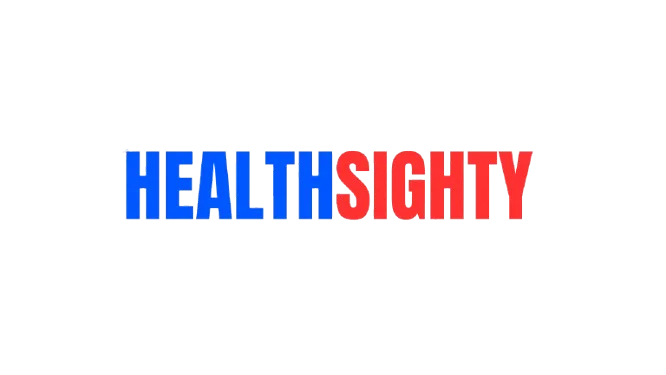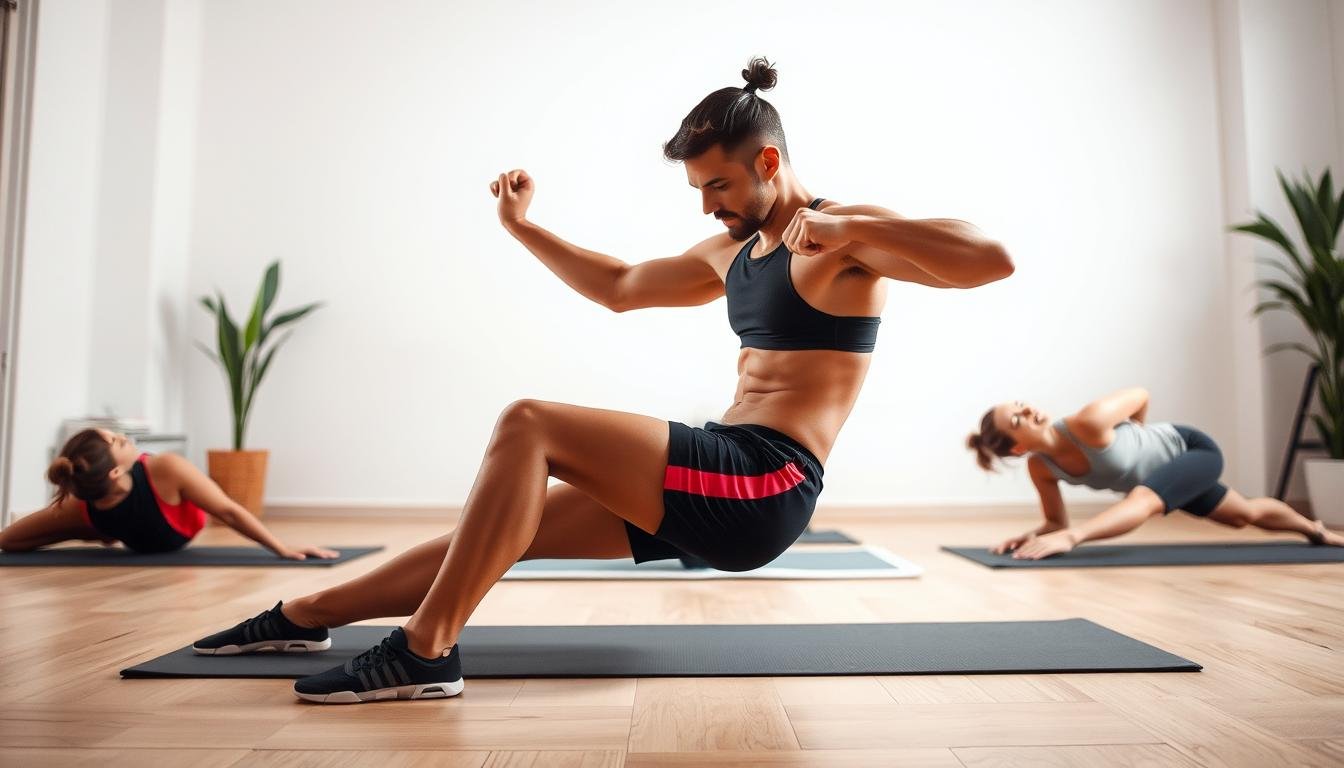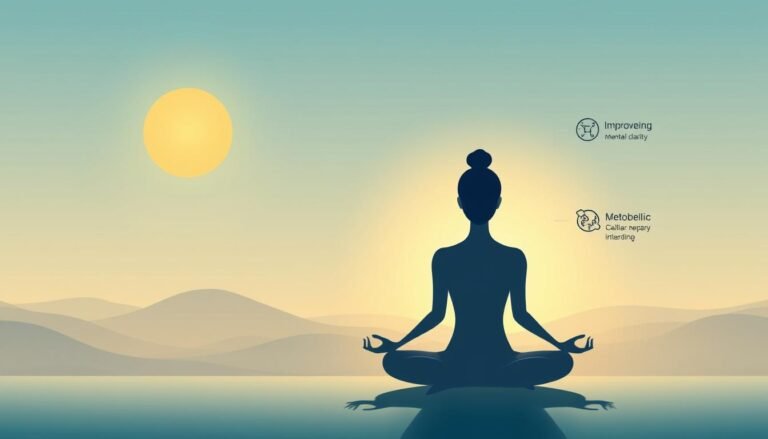Did you know 80% of adults will get back pain at some point? This is often because of weak core muscles. Learning to strengthen your core at home without equipment can greatly improve your fitness and health.
Building abs without equipment is not only doable but also very effective. Your core is more than just a six-pack. It’s the central power of your body that supports all your movements. With a strong core workout at home, you can boost your physical strength and stability without going to the gym.
This guide will teach you how to strengthen your core using just your body weight and practice. Whether you’re new to fitness or want to improve your routine, these tips will help you build a strong and resilient core.
Key Takeaways
- Core strength is crucial for overall body stability and injury prevention
- Bodyweight exercises can effectively strengthen your core muscles
- No expensive equipment is needed to develop a strong core
- Consistent practice leads to significant improvements in core strength
- Core training benefits daily activities and athletic performance
Understanding Core Muscles and Their Importance
Your core is more than just visible abs. It’s a complex network of muscles crucial for stability and movement. A no-equipment core strengthening routine can change how you move and perform daily tasks.
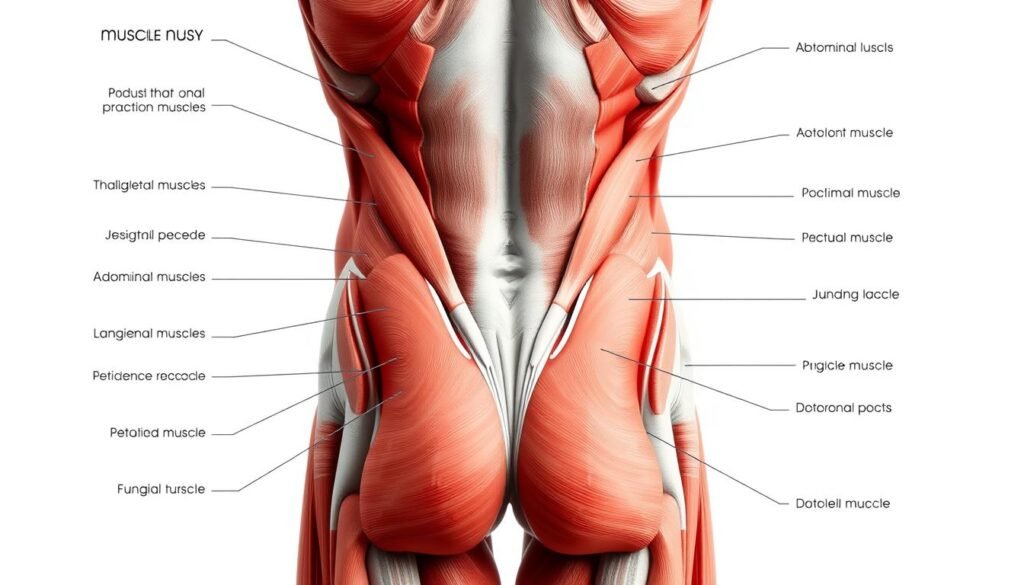
The core muscles form a protective cylinder around your spine. They connect your upper and lower body. These muscles work together to provide stability, support, and power for almost every movement.
Anatomy of Your Core Muscles
Your core includes several key muscle groups:
- Rectus Abdominis (six-pack muscles)
- Transverse Abdominis (deep stabilizing muscles)
- Oblique muscles (side abdominal muscles)
- Lower back muscles
- Diaphragm
- Pelvic floor muscles
Benefits of a Strong Core Beyond Aesthetics
Core exercises using body weight only offer many benefits beyond looks:
| Benefit | Impact |
|---|---|
| Improved Posture | Reduces back pain and alignment issues |
| Better Balance | Prevents falls and improves athletic performance |
| Enhanced Stability | Supports everyday movements and reduces injury risk |
Daily Activities That Benefit from Core Strength
A home ab workout for strength and stability enhances daily activities. Simple core exercises for beginners can improve:
- Lifting groceries
- Maintaining proper sitting posture
- Preventing back strain
- Improving overall body movement
Understanding your core is the first step toward developing a stronger, more resilient body. By incorporating these insights, you’ll be ready to build a powerful core foundation.
How to Build a Stronger Core at Home – No Equipment Required
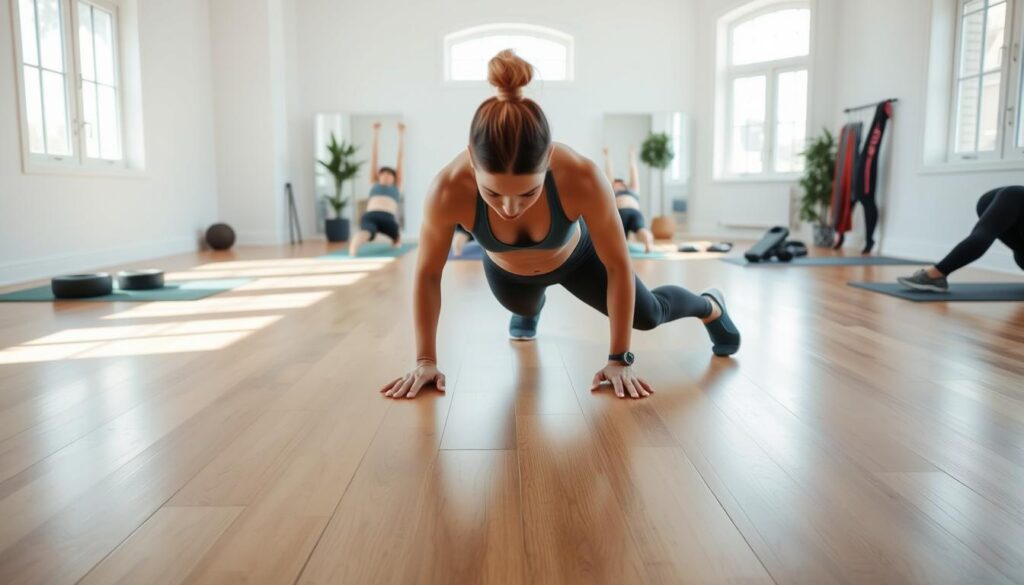
Getting toned abs at home is easy and doesn’t need fancy gym gear. You can do a quick core workout in your living room with just your body and willpower. Training your core without machines is not only doable but also very effective.
Your home workout plan should aim to work many muscles at once. It’s all about being consistent and using the right techniques. This way, you can strengthen your abs anywhere, anytime.
- Choose exercises that engage your entire core
- Practice correct form to maximize results
- Start with basic movements and progress gradually
Bodyweight exercises have special benefits for your core:
| Benefit | Description |
|---|---|
| Flexibility | Perform workouts anywhere without equipment |
| Muscle Engagement | Activates stabilizer muscles more effectively |
| Cost-Effective | Zero investment beyond your own motivation |
Remember, your body is the most versatile piece of workout equipment you’ll ever own. By learning bodyweight core exercises, you can change your fitness journey without going to the gym.
Essential Body Weight Exercises for Core Development
Building a strong core doesn’t need fancy gym gear. You can do a great no-equipment core workout at home. The best moves for a strong core work many muscles at once.
Learning key exercises is key to a strong core. Your core muscles are more than abs. They’re a network that keeps your body stable.
Technique Mastery for Maximum Results
Good form is crucial for effective core training. Keep these tips in mind:
- Keep your spine straight during exercises
- Engage your core before moving
- Match your breathing to your movements
- Use slow, controlled movements
Essential Core Exercise Techniques
Here are some top bodyweight exercises for your core:
- Planks: Great for stability and endurance
- Russian Twists: Works your obliques and rotational strength
- Bicycle Crunches: Engages your core fully
- Mountain Climbers: A dynamic full-body workout
Breathing for Enhanced Core Activation
Your breath is a powerful tool in core training. Exhale during the toughest part of each move. This boosts muscle engagement and stability.
| Exercise | Primary Muscles Worked | Difficulty Level |
|---|---|---|
| Plank | Entire Core Stabilization | Beginner to Advanced |
| Russian Twist | Obliques, Rectus Abdominis | Intermediate |
| Mountain Climbers | Full Core, Cardiovascular System | Advanced |
Common Mistakes to Avoid
Be careful of these common mistakes in your core workout:
- Arching your back during planks
- Using momentum instead of muscle control
- Holding breath during exercises
- Neglecting proper warm-up
Creating Your Home Core Workout Schedule
Creating a good flat belly workout at home needs careful planning. You can make a core workout fit your busy life. This way, you can keep making progress without feeling overwhelmed.
To make a great plan for abs and core exercises at home, remember these important points:
- Frequency: Aim for 3-4 core sessions per week
- Duration: 15-30 minutes per workout
- Rest periods: Allow 24-48 hours between intense core training
Your no gym core sculpting plan should aim to work all muscle groups. Variety is crucial for preventing plateaus and maintaining motivation.
Here’s a sample weekly core workout plan:
- Monday: Lower core focus
- Wednesday: Upper core and obliques
- Friday: Full core circuit
- Sunday: Active recovery or light stretching
Getting better is important in any home core workout. Start with simple exercises and then make them harder by:
- Adding repetitions
- Increasing hold times
- Introducing more complex movement patterns
Pay attention to your body and change the intensity if needed. Your core workout should push you but not hurt you.
Progressive Core Training: From Beginner to Advanced
Building a strong core takes time and a plan that fits your fitness level. Your journey to a stronger core at home is not quick. It’s about steady progress and regular practice. Doing functional core training at home can boost your strength, balance, and fitness.
Core control and balance exercises are key for a strong midsection. It’s important to remember that everyone’s core journey is different. It should be tailored to your own abilities.
Beginner-Friendly Core Moves
For beginners, start with basic exercises that improve core awareness and strength. These exercises will show you how effective core workouts can be at home:
- Planks (30-second holds)
- Dead bug exercise
- Bird dog movement
- Supine leg lifts
Intermediate Core Challenges
When you get better, try more complex and dynamic movements. These exercises will test your core stability:
- Russian twists
- Mountain climbers
- Side planks with rotations
- Bicycle crunches
Advanced Core Strengthening Techniques
For those who are more experienced, these techniques will challenge your core strength even more:
- Hanging leg raises
- Hollow body holds
- Dragon flags
- Advanced plank variations
“Progression is personal. Listen to your body and advance when you feel ready.” – Fitness Experts
Consistency is more important than how hard you work. Your journey to a stronger core at home needs patience, proper form, and gradual challenges.
Core Exercises for Better Posture and Back Health
Your core muscles are key for good posture and back health. Building a strong midsection at home helps your spine stay aligned. It also makes your body more stable.
Having a strong core does more than look good. It supports your whole body. Without weights, you can change how you move every day.
- Strengthens deep stabilizing muscles
- Reduces risk of lower back injuries
- Improves overall body mechanics
- Enhances balance and coordination
Here are some key exercises to help you build a strong core at home:
- Planks: Engage your entire core while maintaining a straight body line
- Bird Dogs: Improve spinal stability and balance
- Dead Bugs: Strengthen deep abdominal muscles
- Superman Holds: Target lower back and posterior core muscles
Focus on proper form and controlled movements. Breathe steadily and keep your spine neutral. This helps you get the most benefits without strain.
| Exercise | Primary Muscles Targeted | Posture Benefit |
|---|---|---|
| Planks | Transverse Abdominis | Improves Spinal Alignment |
| Bird Dogs | Lower Back, Glutes | Enhances Stability |
| Dead Bugs | Deep Core Muscles | Reduces Lower Back Strain |
| Superman Holds | Posterior Chain | Strengthens Back Support |
Be consistent to build core strength. Do these exercises 3-4 times a week. This will help improve your posture and back health.
Nutrition Tips to Support Core Development
Fueling your body right is key for home ab exercises and a strong core. What you eat helps with muscle recovery, growth, and performance in your no-equipment ab routine.
Building a strong core is more than just working out. What you eat can greatly affect your results in flat stomach exercises at home and muscle building.
Foods That Help Build Core Strength
Choosing the right foods can boost your core exercises without gym results. Here are some powerful food groups:
- Lean Proteins: Chicken, fish, tofu, and eggs help muscles repair
- Complex Carbohydrates: Quinoa, sweet potatoes, and brown rice give lasting energy
- Healthy Fats: Avocados, nuts, and olive oil reduce inflammation
Meal Timing for Optimal Results
Planning your meals can improve your core workout results. Eat a balanced meal with protein and carbs 1-2 hours before working out to boost performance.
Hydration Guidelines
Drinking enough water is crucial for muscle function and recovery. Drink at least 8-10 glasses of water a day. Increase this on workout days to help strengthen your core.
Remember, nutrition is the foundation of any successful fitness strategy.
Measuring Your Core Strength Progress
Tracking your progress in home workouts for core strength is key to staying motivated. It helps you understand your fitness journey. Knowing how to measure improvements is crucial for success in bodyweight core exercises.
Begin by setting baseline measurements for your core strength. These initial assessments will help you track your progress in abs workout at home without tools:
- Plank hold duration
- Number of consistent repetitions
- Postural improvements
- Reduced lower back discomfort
Pro tip: Don’t just rely on visual changes. Core strength goes beyond aesthetic appearance.
“Progress is not always visible in the mirror, but it’s always felt in your body’s performance.” – Fitness Experts
To effectively track how to strengthen your core naturally, consider these measurement techniques:
- Take monthly progress photos from multiple angles
- Record exercise performance metrics
- Note improvements in daily functional movements
- Track your ability to maintain proper form during exercises
Remember, core strength is about functional fitness, not just six-pack abs. Celebrate improvements in your overall body stability, balance, and everyday movement capabilities.
Quick Core Routines for Busy Schedules
Finding time for fitness can be tough. But, building core muscles doesn’t need hours of work. With smart no gear core training, you can make short times into strong core-strengthening chances.
Busy people and home fitness fans can find easy at-home core workouts. These fit well into tight schedules. They help build core muscles without equipment and keep strength training going.
5-Minute Core Blasts
Make the most of your short time with intense core exercises. They give big results:
- 30-second plank holds
- 20 Russian twists
- 15 bicycle crunches
- 10 mountain climbers
Lunch Break Core Workouts
Turn your lunch break into a core workout. These quick routines need little space and no equipment:
- Standing core rotations
- Wall sits with abdominal engagement
- Seated leg lifts
Before-Bed Core Sequences
Relax while building core strength with soft yet effective moves. Consistency is key in developing a strong, resilient core.
- Supine leg raises
- Gentle twists
- Slow, controlled breathing exercises
Even short 5-10 minute sessions can boost your core strength if done often. Your body will appreciate these focused, quick workouts.
Conclusion
Building a stronger core at home without machines is easier than you think. Your journey starts with commitment and regular exercises. You can use simple bodyweight movements that don’t need expensive gear.
A daily core workout plan is about sticking with it, not being perfect. You’ve seen how a strong core affects your posture and sports skills. By following this guide, you can build a strong core that helps you reach your fitness goals. Remember, every small step helps you get closer to your goal of a stronger body.
Core workouts without machines are flexible and easy to fit into your day. You can do them in just five minutes or thirty. Start with simple exercises, focus on doing them right, and then make them harder. Your body will get stronger with regular effort, helping you in all physical activities and improving your health.
Your core transformation begins today. Be patient with yourself and trust the journey. With dedication and the right steps, you’ll become a stronger, more confident person, one workout at a time.
FAQ
How often should I do core workouts at home?
Aim for 3-4 core workouts at home each week. Make sure to rest at least one day between sessions. Beginners can start with 2-3 times a week and increase as they get stronger.
Can I really build core strength without any equipment?
Yes, you can! Bodyweight exercises are great for strengthening your core. Try planks, Russian twists, bicycle crunches, and leg raises. You don’t need any equipment.
How long will it take to see results in my core strength?
Seeing results takes time and effort. Most people notice improvements in 4-6 weeks. But, it depends on your diet, fitness level, and how hard you work out.
Are core workouts suitable for people with back problems?
Core exercises can help with back pain, but talk to a doctor first. Start with easy exercises and focus on doing them right to avoid making things worse.
How long should a typical home core workout last?
A good core workout can be done in 10-15 minutes. Even a 5-minute routine can be beneficial if done regularly and correctly.
Do I need to do cardio along with core exercises?
Core exercises are important, but so is cardio and strength training. Try to do cardio 3-5 times a week to go along with your core workouts.
Can core exercises help me lose belly fat?
Core exercises strengthen muscles, but they don’t burn fat. To lose belly fat, you need to exercise regularly, eat well, and have a calorie deficit. Core workouts can help tone, but diet is key for fat loss.
What if I can’t do a full plank or other advanced core exercises?
No problem! Most exercises have easier versions. For planks, try them on your knees or use a wall. Start with shorter holds and get stronger over time.
How important is breathing during core exercises?
Breathing is very important for core exercises. Breathe out when it’s hard and in when it’s easy. This helps keep your core stable and prevents holding your breath.
Can I do core exercises every day?
It’s tempting, but not a good idea. Your muscles need rest to get stronger. Aim for 3-4 core workouts a week with rest days in between to avoid injury.
